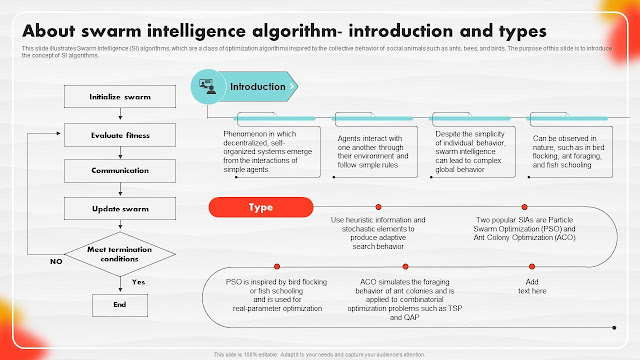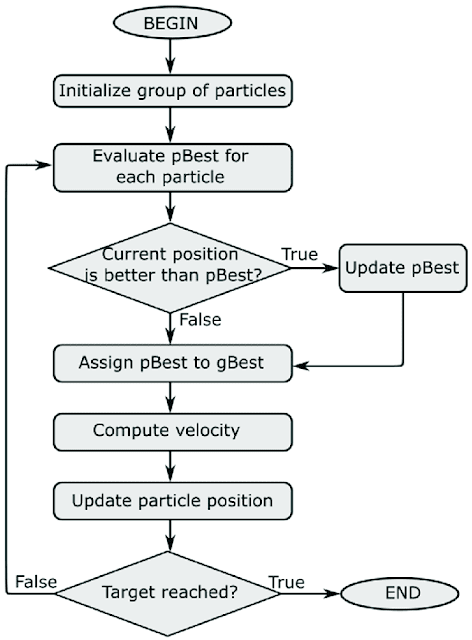 |
| SWARM INTELLIGENCE |
Swarm algorithms are a fascinating branch of artificial intelligence inspired by the behavior of natural groups like flocks of birds, schools of fish, colonies of ants, or hives of bees. These algorithms simulate collective behavior to solve problems that are difficult or time-consuming for traditional methods. Let’s dive into the basics of swarm algorithms and explore their real-world applications with simple examples.
 |
What Are Swarm Algorithms?
Swarm algorithms use a group of simple, autonomous agents (like particles, ants, or bees) that interact locally with each other and their environment. Despite having no central control, these agents work together to find optimal solutions to complex problems. This collective intelligence allows swarm algorithms to adapt, self-organize, and efficiently solve tasks.
Key Characteristics of Swarm Algorithms:
- Decentralized Control: No single agent controls the system; decisions are made locally.
- Emergent Behavior: Simple individual actions lead to complex group behavior.
- Scalability: Works well with both small and large numbers of agents.
- Robustness: Can handle failures of individual agents without affecting the overall system.
SI Types
 |
| SI Category and Types |
Popular Swarm Algorithms and Their Applications
1. Particle Swarm Optimization (PSO)
Inspiration: Flocking behavior of birds or fish.
Description: In PSO, each agent (or particle) represents a potential solution to a problem. These particles explore the "solution space" by adjusting their positions based on their own experience and that of their neighbors.
 |
Example:
Imagine a group of birds searching for food in an open field. Each bird (particle) adjusts its flight path based on where it has found food and where it sees other birds gathering. Over time, the flock converges toward the area with the most food.
Applications:
- Tuning machine learning models (e.g., optimizing hyperparameters).
- Solving engineering design problems.
- Predicting financial trends.
2. Ant Colony Optimization (ACO)
 |
| ACO in Real World |
Inspiration: Foraging behavior of ants.
Description: Ants leave pheromone trails to mark paths leading to food. Over time, shorter paths accumulate more pheromones as more ants travel them, helping the colony find the best route.
Example:
Consider a delivery company trying to optimize routes for its trucks. Virtual "ants" simulate all possible routes between destinations. As the algorithm progresses, the most efficient routes (shortest or fastest) are reinforced by "pheromone trails," eventually leading to an optimal delivery schedule.
Applications:
- Route optimization (e.g., delivery networks, traffic systems).
- Solving scheduling problems (e.g., exam timetables).
- Network routing in telecommunications.
3. Artificial Bee Colony (ABC)
 |
| ABC in Real World |
Inspiration: Bees searching for nectar.
Description: In the ABC algorithm, "employed bees" search for food sources (solutions), "onlooker bees" evaluate these sources, and "scout bees" explore new areas. The algorithm iteratively improves the solution by focusing on the best sources.
 |
Example:
Picture a group of bees exploring a garden to find flowers with the most nectar. Some bees focus on areas already known to be rich in nectar, while others scout for new flowers. Over time, the bees maximize their nectar collection.
Applications:
- Resource allocation in factories.
- Solving numerical optimization problems.
- Optimizing energy usage in smart grids.
4. Boids (Flocking Simulation)
 |
| Boids in Real World |
Inspiration: Behavior of bird flocks and fish schools.
Description: Boids simulate agents moving in a coordinated way using three simple rules: cohesion (stay close to the group), separation (avoid collisions), and alignment (match the group's direction).
Example:
Think of a flock of birds flying together. Each bird adjusts its position to stay close to the group without crashing into others, creating a visually stunning and synchronized movement.
Applications:
- Animation and special effects in movies.
- Modeling crowd behavior in simulations.
- Coordinating drones or robotic swarms.
5. Firefly Algorithm
 |
| Firefly in Real World |
Inspiration: Flashing behavior of fireflies to attract mates or prey.
Description: In this algorithm, fireflies represent solutions, and their brightness indicates the quality of the solution. Fireflies move toward brighter ones, improving the overall solution.
 |
Example:
Imagine fireflies in a dark forest. Each firefly flashes to attract others based on the quality of its location (solution). Over time, they gather in the brightest areas, representing the best solutions.
Applications:
- Solving complex engineering problems.
- Clustering in data mining.
- Optimizing machine learning algorithms.
Practical Applications of Swarm Algorithms
Swarm algorithms have real-world applications across various fields, thanks to their adaptability and efficiency:
Robotics:
- Coordinating multiple robots to perform tasks like warehouse automation or search-and-rescue operations.
- Example: Swarm drones for agricultural monitoring.
Transportation and Logistics:
- Optimizing routes for delivery trucks, trains, and public transport systems.
- Example: Reducing delivery times for e-commerce giants like Amazon.
Telecommunications:
- Routing data in large networks to ensure efficient communication.
- Example: Mobile network traffic optimization.
- Improving imaging and diagnosis by analyzing patterns in medical data.
- Example: Swarm-based segmentation of MRI images.
- Simulating realistic movement in large crowds or animal groups.
- Example: Creating realistic bird flocks in animated films.
Advantages of Swarm Algorithms
- Adaptability: They work well in dynamic environments where conditions change.
- Decentralized Control: No single point of failure, making them robust.
- Scalability: Can handle problems with increasing complexity as the number of agents grows.
- Efficiency: Provide near-optimal solutions quickly in many cases.
Source for Above Images:



